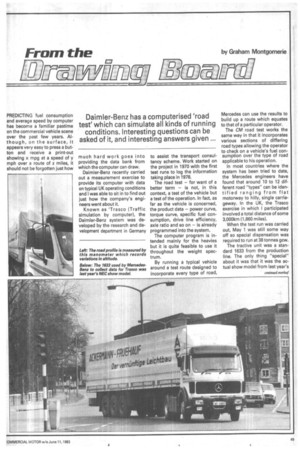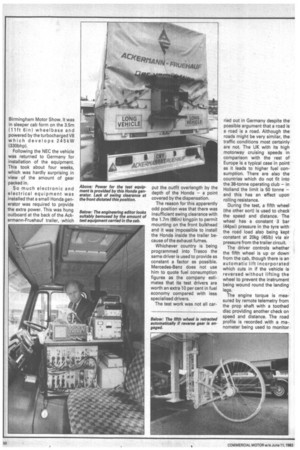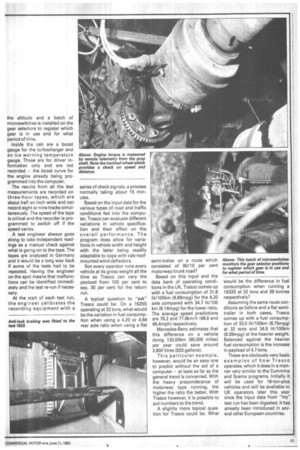IIMLNYDI2••' - '07 FRI PREDICTING fuel consumption and average speed by computer
Page 51

Page 52

Page 53

If you've noticed an error in this article please click here to report it so we can fix it.
has become a familiar pastime on the commercial vehicle scene over the past few years. Although, on the surface, it appears very easy to press a button and receive a print-out showing x mpg at a speed of y mph over a route of z miles, it should not be forgotten just how
much hard work goes into providing the data bank from which the computer can draw.
Daimler-Benz recently carried out a measurement exercise to provide its computer with data on typical UK operating conditions and I was able to sit in to find out just how the company's engineers went about it.
Known as 'Trasco (Traffic simulation by computer), the Daimler-Benz system was developed by the research and development department in Germany to assist the transport consultancy scheme. Work started on the project in 1970 with the first test runs to log the information taking place in 1978.
The road test — for want of a better term — is not, in this context, a test of the vehicle but a test of the operation. In fact, as far as the vehicle is concerned, the product data — power curve, torque curve, specific fuel consumption, drive line efficiency, axle ratio and so on — is already programmed into the system.
The computer program is intended mainly for the heavies but it is quite feasible to use it throughout the weight spectrum.
By running a typical vehicle around a test route designed to incorporate every type of road, Mercedes can use the results to build up a route which equates to that of a particular operator.
The CM road test works the same way in that it incorporates various sections of differing road types allowing the operator to check on a vehicle's fuel consumption over the type of road applicable to his operation.
In most countries where the system has been tried to date, the Mercedes engineers have found that around 10 to 12 different road "types" can be identified ranging from flat motorway to hilly, single carriageway. In the UK, the Trasco exercise in which I participated involved a total distance of some 3,000km (1,860 miles).
When the test run was carried out, May 1 was still some way off so special dispensation was required to run at 38 tonnes gcw.
The tractive unit was a standard 1633 from the production line. The only thing "special" about it was that it was the actual show model from last year's Birmingham Motor Show. It was in sleeper cab form on the 3.5m (lift 6in) wheelbase and powered by the turbocharged V8 which develops 245 kW (330bhp).
Following the NEC the vehicle was returned to Germany for installation of the equipment. This took about four weeks, which was hardly surprising in view of the amount of gear packed in.
So much electronic and electrical equipment was installed that a small Honda generator was required to provide the extra power. This was hung outboard at the back of the Ackermann-Fruehauf trailer, which put the outfit overlength by the depth of the Honda — a point covered by the dispensation.
The reason for this apparently odd position was that there was insufficient swing clearance with the 1.7m (66in) kingpin to permit mounting on the front bulkhead and it was impossible to install the Honda inside the trailer because of the exhaust fumes.
Whichever country is being programmed into Trasco the same driver is used to provide as constant a factor as possible. Mercedes-Benz does not use him to quote fuel consumption figures as the company estimates that its test drivers are worth an extra 10 per cent in fuel economy compared with less specialised drivers.
The test work was not all car ried out in Germany despite the possible argument that a road is a road is a road. Although the roads might be very similar, the traffic conditions most certainly are not. The UK with its high motorway cruising speeds in comparison with the rest of Europe is a typical case in point as it leads to higher fuel consumption. There are also the countries which do not fit into the 38-tonne operating club — in Holland the limit is 50 tonne — and this has an effect upon rolling resistance.
During the test, a fifth wheel (the other sort) is used to check the speed and distance. The wheel has a constant 3 bar (44psi) pressure in the tyre with the road load also being kept constant at 20kg (451b) via air pressure from the trailer circuit.
The driver controls whether the fifth wheel is up or down from the cab, though there is an automatic lift incorporated which cuts in if the vehicle is reversed without lifting the wheel to prevent the instrument being wound round the landing legs.
The engine torque is measured by remote telemetry from the prop shaft with a toothed disc providing another check on speed and distance. The road profile is recorded with a manometer being used to monitor the altitude and a batch of microswitches is installed on the gear selectors to register which gear is in use and for what period of time.
Inside the cab are a boost gauge for the turbocharger and an ice warning temperature gauge. These are for driver information only and are not recorded — the boost curve for the engine already being programmed into the computer.
The results from all the test measurements are recorded on three-hour tapes, which are about half an inch wide and can record eight or nine tracks simultaneously, The speed of the tape is critical and the recorder is programmed to switch off if the speed varies.
A test engineer always goes along to take independent readings as a manual check against what is going on to the tape. The tapes are analysed in Germany and it Would be a long way back if some of the tests had to be repeated. Having the engineer on the spot means that malfunctions can be identified immediately and the test re-run if necessary.
At the start of each test run, the engineer calibrates the recording equipment with a series of check signals, a process normally taking about 15 minutes.
Based on the input data for the various types of road and traffic conditions fed into the computer, Trasco can evaluate different variations in vehicle specification and their effect on the overall performance. The program does allow for variations in vehicle width and height with the latter being readily adaptable to cope with cab.-roofmounted wind deflectors.
Not every operator runs every vehicle at its gross weight all the time so Trasco can vary the payload from 100 per cent to say, 30 per cent for the return run.
A typical question to "ask" Trasco could be: On a 16255 operating at 32 tons, what would be the variation in fuel consumption when using a 4.20 or 4.64 rear axle ratio when using a flat semi-trailer on a route which consisted of 90/10 per cent motorway/trunk road?
Based on this input and the data bank of operating conditions in the UK, Trasco comes up with a fuel consumption of 31.8 lit/100km (8.89mpg) for the 4.20 axle compared with 34.7 lit/100 km (8.14mpg) for the lower ratio. The average speed predictions are 78.2 and 77.9km/h (48.6 and 48.4mph) respectively.
Mercedes-Benz estimates that this difference on a vehicle doing 130,00km (80,000 miles) per year could save around 3,800 litres (833 gallons).
This particular example, however, would be an easy one to predict without the aid of a computer — at least as far as the general trend is concerned. With the heavy preponderance of motorway type running, the higher the ratio the better, With Trasco however, it is possible to put numbers to the trend.
A slightly more topical question for Trasco could be: What would be the difference in fuel consumption when running a 1633S at 32 tons and 38 tonnes respectively?
Assuming the same route conditions as before and a flat semitrailer in both cases, Trasco comes up with a fuel consumption of 33.0 lit/100km (8.75mpg) at 32 tons and 34.9 lit/100km (8.09mpg) at the heavier weight. Balanced against the heavier fuel consumption is the increase in payload of 4.7 tons.
These are obviously very basic examples of how Trasco operates, which it does in a manner very similar to the Cummins and Scania programs. Initially it will be used for 16-ton-plus vehicles and will be available to UK operators later this year once the input data from "my" test run has been digested. It has already been introduced in several other European countries.
































































































